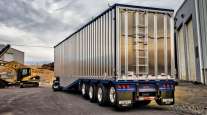Senior Reporter
Used Class 8 Demand in March Remains Strong

The market for used Class 8s in March continued to butt heads with a lack of inventory amid still-strong demand. Sales slipped, and prices rose.
The average price of a Class 8 truck in March climbed to $45,951 compared with $42,232 in the 2018 period.
The average price year-to-date rose to $47,157. That was up 10% compared with $42,706 a year earlier.
“It is still a story of truckers looking at the market and looking at how good rates are doing and wanting to jump in, even at what we believe to be this late hour,” ACT Research Vice President Steve Tam said.

Tam
“We have really not heard, other than just a handful of reports, of folks saying they are seeing demand soften on their [sales] side,” he said.
Dry van and refrigerated van spot rates per mile in March were just a few pennies below where they were in February, while flatbed rates rose 1 cent, according to load board operator DAT Solutions.
At the same time, “We think the full-industry sales volume was 20,500, down 15%, compared with 24,100 a year earlier,” Tam said. ACT surveys dealers, wholesalers and auctioneers as well as a few large fleets to determine average prices, age and mileage, and volumes.
Sales year-to-date were 61,500, down 12%, compared with 70,000 last year.
“So we made up a little ground in March,” he said.
The story continues to be most of the dealers still are complaining about a lack of inventory, he added.
As a backdrop to the used truck market, the Department of Commerce reported first-quarter GDP was 3.2%, although that is an advance estimate and subject to later revisions.
In related news, the international trade deficit decreased in February to $49.4 billion compared with $51.1 billion in January as exports increased more than imports, according to the department’s Bureau of Economic Analysis.
“That is good news, but we’ll see. We’ll have two more releases before it’s final. And I am guessing [GDP] will get shaved a little bit,” Tam said.

The upshot of the report for trucking, though, is freight still is moving.
“That increases the possibility of this year staying a little stronger for a little bit longer. So we may see an uptick in expectations for 2019,” he said.
But that also would mean 2020 turns softer, he added. “We are robbing Peter to pay Paul. The deficit on the bottom end is going to be bigger next year. That’s the conventional thinking.”
In the meantime, mileage on the average Class 8 was flat at 453,000 compared with a year ago when it was 452,000. The age increased to 7 years, 2 months, up from 6 years, 9 months.
A recent first-quarter survey of Paccar dealers — who sell the Kenworth Truck Co. and Peterbilt Motors Co. brands — found 60% of dealers reported that used truck demand at their dealership had increased compared with demand in the fourth quarter — “an increase from our prior survey when 50% of contacts cited a quarter-over-quarter increase,” wrote Neil Frohnapple, a senior analyst with The Buckingham Research Group.
In the survey, 50% of dealers cited a modest uptick in wholesale used truck prices on average in the first quarter compared with the fourth quarter, he wrote. “However, a few contacts did note some early sign of weakness for used sleepers.”
Another truck dealer said used truck sales were flat in the first quarter compared with a year earlier but that revenue increased 3%.

Rush
“Used truck values remain stable but may face price pressure later this year. We believe our used truck inventory and pricing can effectively support market demand,” W.M. “Rusty” Rush, chairman and CEO of Rush Enterprises, said during a quarterly earnings conference call in April.
Publicly traded Rush has about 120 dealerships in 22 states.
Meanwhile, the average sleeper tractor retailed in March was 5 years, 9 months old. It had 467,319 miles and brought $55,808, Chris Visser, senior analyst for commercial vehicles at J.D. Power, wrote in a recent blog. Compared with March 2018, this average sleeper was two months newer and had 5,140, or 1.1%, more miles. It brought $7,321, or 15.1%, more money.




